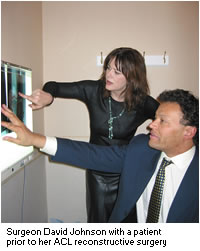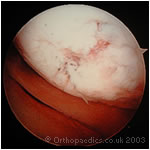


o r t h o p a e d i c s . c o . u k

| +home | |
| +news | |
| +research | |
| +patient infomation | |
| +the clinic | |
| +the surgeon | |
| +sport physiotherapy | |
| +sports advice | |
| +products | |
| +resources | |
| +contact | |
| +maps & directions | |
| +site map |
|
The Bristol Orthopaedic |
Anterior Cruciate Ligament Reconstruction - ACL - Introduction
What is Anterior Cruciate Ligament Reconstruction (ACL)?
 Anterior Cruciate Ligament (ACL) reconstruction or repair is undertaken when the Anterior Cruciate Ligament (ACL) is ruptured and a patient complains of knee instability, pain or recurrent swelling. Direct repair or suture of the Anterior Cruciate Ligament (ACL) has historically proven to be unsuccessful. Reconstruction using artificial ligaments were popular in the 1970's and 80's but these too proved to be prone to failure by rupture of the replacement or an adverse tissue reaction.
Anterior Cruciate Ligament (ACL) reconstruction or repair is undertaken when the Anterior Cruciate Ligament (ACL) is ruptured and a patient complains of knee instability, pain or recurrent swelling. Direct repair or suture of the Anterior Cruciate Ligament (ACL) has historically proven to be unsuccessful. Reconstruction using artificial ligaments were popular in the 1970's and 80's but these too proved to be prone to failure by rupture of the replacement or an adverse tissue reaction.
The current procedures are reliable and involve replacement of the original Anterior Cruciate Ligament (ACL) by a graft taken from the patients' own local tendons. These procedures can be undertaken entirely by minimally invasive, keyhole or arthroscopic technique. This avoids the need for large skin incisions, allow for accurate placement of the ligament and allow rapid recovery and rehabilitation whilst minimizing pain swelling and stiffness. These procedures can be expected to allow patients to return to unrestricted sports in the vast majority of cases.
Anatomy of the ligaments
The anatomy of the knee is such that the two most important groups of muscles supporting the knee are the quadriceps muscle, which is the large bulk of muscle lying at the front of the thigh, and the hamstrings which lie behind the thigh. The ligaments, which stabilise the knee, consist of the collateral ligaments; medial and lateral, lying either side of the knee and the cruciate ligaments, anterior (ACL) and posterior cruciate ligament (PCL), lying within the joint. The fibrous capsule, which surrounds the knee, completes the stability of the joint.
How ACL injuries occur
The Anterior Cruciate Ligament (ACL) can be injured in many different ways. This usually involves an injury in which the knee is subject to abnormal forces that temporarily dislocate the knee stretching the Anterior Cruciate Ligament (ACL). When the knee suffers abnormal forces two things may occur. Firstly these forces may lead to damage to the menisci or cartilages in the knee. Secondly the restraining structures or ligaments may be damaged. This damage may be a simple stretching or sprain of the ligaments, or alternately may be more serious such as a complete rupture of a ligament. Unfortunately the ligament is usually completely ruptured by such an injury. A partial tear of the Anterior Cruciate Ligament (ACL) in which a substantial part of the ligament remains functional with a stable knee is unusual.
Hold your mouse over the image for a description



A rupture of the anterior cruciate ligament may occur in isolation or more often occurs with damage to other structures. Structures commonly damaged with the anterior cruciate ligament are the medial collateral ligament, which is the ligament on the inner side of the knee, and the cartilages or menisci. There is usually significant damage to the capsule of the knee, further destabilising the joint. The articular surface of the knee may also suffer some damage in up to 83% of cases. This occurs particularly where a significant amount of impaction force has occurred. This is common in road traffic accidents or high-speed skiing accidents.
Following rupture of the Anterior Cruciate Ligament (ACL) the knee gives way and there is usually instability, pain and swelling of the knee. With time the pain and swelling may resolve with conservative treatment, however the instability may persist and leads to the knee giving way without warning, usually associated with an attempt to twist or change direction. Accordingly the majority of stick and ball games, will not be possible without episodes of knee instability.Each time the knee gives way this can cause further damage to the internal structures of the knee, particularly the cartilages or menisci. The amount of stress on the knee required to cause giving way varies and is influenced by the amount of damage to other structures of the knee. It is the frequency of giving way, the consequences of further damage to the knee and the degree of disability this causes which are the prime determinants influencing patients decisions to undergo reconstruction of the anterior cruciate ligament (ACL).
< BACK to ACL Reconsruction Index | NEXT: Indications / Contra - indications >
Related Links..
+ How to make an appointment
+ Anterior Cruciate Ligament Reconstruction - see all links
+ Patient Information home
+ See the clinic
+ More about Mr Johnson
+ top
Related Links..
+ Patient Information home
+ More about Mr Johnson
© The Bristol Orthopaedic & Sports Injury Clinic 2003. privacy | contact | Powered By Create Medical